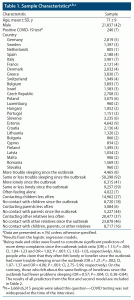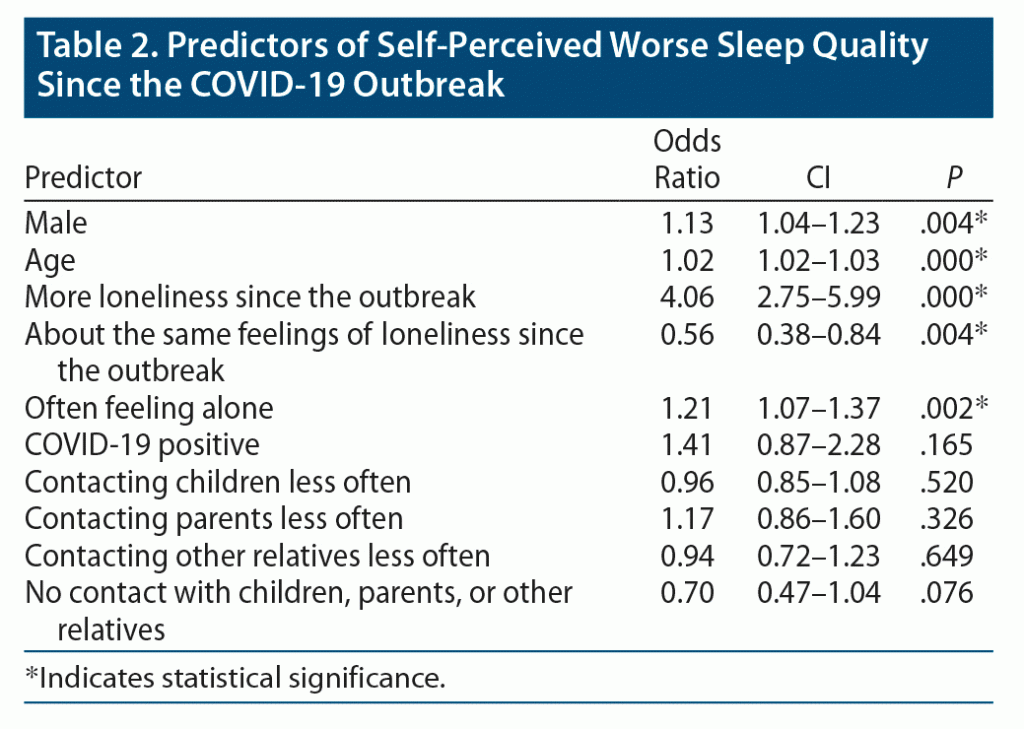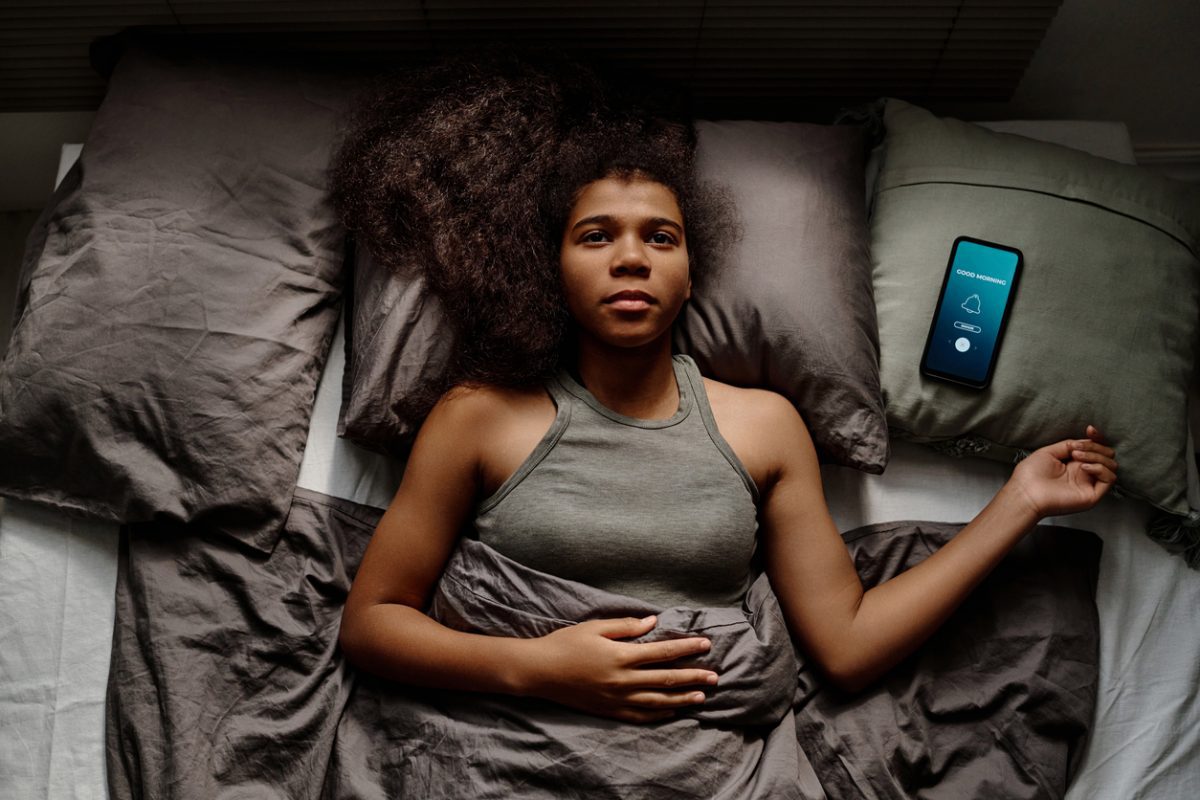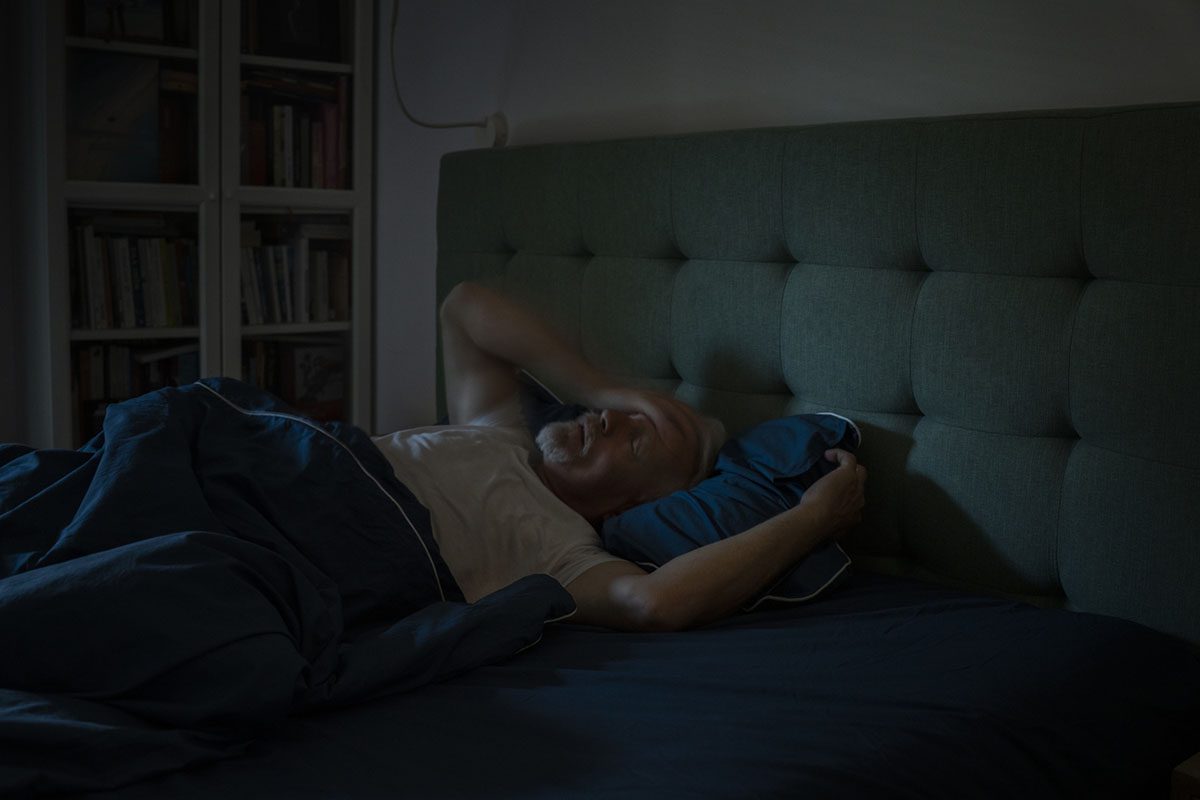ABSTRACT
Objective: The coronavirus disease 2019 (COVID-19) pandemic has had a major impact globally. While sleep problems have increased during the pandemic, their impact on specific populations is less well known. The objective of this study was to measure the impact of the COVID-19 pandemic on sleep and how it correlates with the feeling of isolation in individuals aged ≥ 50 years.
Methods: A cross-sectional study was conducted using data from the Survey of Health, Aging, and Retirement conducted between June and August 2020. A multivariate logistic regression model was performed to analyze the outcome “more or less trouble sleeping since the outbreak” and its main predictors.
Results: The mean ± SD age of the participants was 71 ± 9 years. Since the outbreak, 29% reported a deterioration of their quality of sleep. Being male and older were found to be significant predictors of more sleep complaints (OR = 1.13; P = .004; CI, 1.04–1.23 and OR = 1.02; P = .000; CI, 1.02–1.03, respectively). Moreover, those who claimed that they often felt alone or more loneliness since the beginning of the outbreak also had more trouble sleeping (OR = 1.21; P = .002; CI, 1.07–1.37 and OR = 4.06; P = .000; CI, 2.75–5.99, respectively).
Conclusions: Male sex, older age, and loneliness are associated with more sleeping difficulties since the beginning of the COVID-19 pandemic. These findings can aid health authorities to address sleep issues in this vulnerable population more directly.
Prim Care Companion CNS Disord 2022;24(3):21m03224
To cite: Cordeiro CR, Câmara Pestana P, Côrte-Real B, et al. Long time, no sleep: sleep in older adults during the COVID-19 pandemic. Prim Care Companion CNS Disord. 2022;24(3):21m03224.
To share: https://doi.org/10.4088/PCC.21m03224
© Copyright 2022 Physicians Postgraduate Press, Inc.
aDepartment of Neurosciences and Mental Health, Psychiatry and Mental Health, Hospital de Santa Maria, Lisbon, Portugal
bFaculdade de Medicina, Universidade de Lisboa, Lisbon, Portugal
cInstituto de Saúde Ambiental, Lisbon, Portugal
*Corresponding author: Catarina Rodrigues Cordeiro, MD, Hospital de Santa Maria—Serviço de Psiquiatria e Saúde Mental, Avenida Professor Egas Moniz, 1649-035 Lisbon, Portugal ([email protected]) (ORCID: https://orcid.org/0000-0001-9910-8203).
The coronavirus disease 2019 (COVID-19) pandemic has had a major impact around the globe. The disease itself but also COVID-related fear and the lockdown with its social consequences have affected most aspects of people’s lives, including their mental health.1,2
Since sleep disorders or inadequate sleep contribute to depression, accidents, heart disease, diabetes, and poor quality of life,3 studies2,4 have paid attention to sleep and sleep disorders during the COVID-19 outbreak. There have been some interesting findings regarding sleep, namely the increase of Google search queries for insomnia,5 the increase in sleep problems in different countries2,4,6 and among health care workers,7 and the differential impact on sleep according to sex.8
Although it is known that the pandemic has had an asymmetric impact on different sections of the population1 and that age is a risk factor for insomnia in people with COVID-19,9 little attention had been paid to the impact of COVID-19 on sleep in one of the most vulnerable subgroups, namely people older than age 50 years. Thus, we sought to measure the impact of the COVID-19 pandemic on sleep problems and how it correlates with the feeling of isolation in this particularly vulnerable population.
METHODS
For this cross-sectional study, we analyzed data from noninstitutionalized people aged ≥ 50 years from the Survey of Health, Aging, and Retirement (SHARE 8-COVID). This database includes 8 periods of data collection in 27 European countries and Israel including a total of more than 140,000 people.
To date, SHARE has conducted 8 waves of data collection and covers all continental European Union countries plus Switzerland and Israel. There is one common generic questionnaire that country teams translate into the national languages (more than 1 language in some countries) using an internet-based translation tool. SHARE includes participants residing in private households and living in nursing homes, aged ≥ 50 years, in various European countries and Israel. Health status, demographic, socioeconomic, and social factors are collected and kept as nationally representative samples. Further details of the study and its protocol can be found in the 2013 article by Börsch-Supan et al.10 For this study, we included data from the eighth wave.
Data were collected via computer-assisted telephone interviews between June and August 2020. As a reaction to the seriousness of the COVID-19 outbreak and the prolonged lockdowns, the SHARE Corona questionnaire was developed. This new questionnaire covers the most important life domains for the target population and asks specific questions about infections and changes in life during the lockdown: health and health behavior, mental health, infections and health care, changes in work and economic situation, and social networks.11
For our analysis, we excluded data from those who were aged < 50 years or had no valid information regarding their age. Depending on the country of origin, oral or written consent was obtained. Further details about this database can be accessed online (www.share-project.org).
Statistical Analysis
Stata software was used to perform the statistical analysis (version 14.2, StataCorp, College Station, Texas). Descriptive statistics were presented as mean ± SD.
For the analysis of our hypothesis, we used 3 multivariate logistic regression models. For all the models, the outcome was “more or less trouble sleeping since the outbreak,” and this variable was recoded as a binary variable to compare “more trouble sleeping since the outbreak” versus “less trouble sleeping since the outbreak” or “no changes in sleep.”
For the first model, the predictors and other covariates were the following variables: sex, age, “more or less lonely since the outbreak,” “how often do you feel lonely,” having a positive test for COVID-19, “contact frequency with own children since outbreak,” “contact frequency with own parents since outbreak,” and “contact frequency with other relatives since outbreak.”
Sex and age were selected because they were considered potential predictors of sleep problems in previous literature.12 We included having a positive test for COVID-19 because it has also been associated with long-term sleep impairment.13 Finally, all the variables included in the database that could be related to loneliness were also included in the model to study our primary hypothesis.
In the second model, a composite variable of the 3 family social contact variables was created as a dichotomous (any versus none) predictor and included in another model with the same predictors except the variables related to visiting due to collinearity.
The third model included only significant independent variables and the COVID-19–positive test variable. Measures of association were expressed as odds ratio (OR), and P ≤ .05 was considered statistically significant.
RESULTS
The sample included a total of 51,625 people: 21,837 men (42%) and 29,788 women (58%). Their mean age was 71 ± 9 years, ranging from 50 to 104 years. Of those who answered the question on previous COVID testing (n = 3,668), 240 (7%) had a positive test for COVID-19 at some point before this interview (6,315 people were asked this question—COVID testing was not widespread at the time of the interview).
Regarding sleep problems, 4,161 people (29%) indicated that since the outbreak their subjective quality of sleep had deteriorated. Among those who responded to the question on loneliness (n = 5,957), 41% admitted that they felt lonelier since the outbreak, 3% felt less lonely, and 59% indicated no change. Those who responded that they often felt alone or more loneliness since the beginning of the outbreak had more trouble sleeping (OR = 1.21; P = .002; CI, 1.07–1.37 and OR = 4.06; P = .000; CI, 2.75–5.99). Also, 16% (n = 8,717) of the sample reported that they had not had a visit from their children, parents, or other relatives since the beginning of the outbreak. Descriptive data are provided in Table 1. Predictors of sleep quality since the COVID-19 outbreak are presented in Table 2. The results showed that being male and older were significantly associated with sleep disturbances (OR = 1.13; P = .004; CI, 1.04–1.23 and OR = 1.02; P < .001; CI, 1.02–1.03, respectively).
The third model, including only significant variables from the first and second model, no longer identified sex as a relevant predictor and instead confirmed that a previous positive test for COVID-19 was a significant predictor of worse sleep (OR = 2.30; P = .002; CI, 1.35–3.92). The rest of the previous predictors kept their significance in this model.
DISCUSSION
From our analysis, we found a worsening of sleep problems in 29% of the sample. Regarding our hypothesis, we confirmed that feelings of isolation (often feeling lonely or lonelier since the outbreak) are independently associated with an increase in sleep problems. Also, we found that being male and older were significantly associated with sleep disturbances. Moreover, the number of social contacts during the lockdown and having a positive test for COVID-19 did not have a statistically significant impact on sleep.
The prevalence of sleep disorders among older adults varies widely across the globe, and there is a lack of studies in this population and a wide range of results that are not always coherent.14,15 Our study showed an increase of sleep problems in 29% of people ≥ 50 years during the COVID-19 pandemic, suggesting an important impact on the sleep patterns of older individuals. The deleterious effect of the pandemic on sleep is well known.16 However, we found no specific study in the geriatric population, even though sleep problems tend to increase with age.17 Our results also showed that age is an independent predictor of increased sleep complaints.
Social participation is known to constitute a protective factor regarding health, in close association with level of physical activity and cognitive functions.18 Therefore, it is not surprising that loneliness appears to be a predictor of poor sleep quality during the COVID-19 pandemic. Also, mental and physical health may be negatively affected due to the social distancing imposed during this period, with a direct impact on sleep quality.19 This is a phenomenon of paramount importance, since it can begin a vicious cycle wherein isolation due to COVID-19 promotes sleep disturbances19 and sleep disturbances promote more social withdrawal and loneliness.20 The geriatric population is particularly vulnerable to isolation, a problem that has certainly increased during the COVID-19 pandemic21 and that can have an important impact on sleep quality.
In this study, sex was also found to be an independent predictor of worse sleep quality since the beginning of the COVID-19 pandemic. In the geriatric population, epidemiologic studies have consistently shown that women have more sleep-related complaints and a higher risk of insomnia than men; however, objective measurements show poorer sleep among men.22 Our results confirm those of other studies23,24 that focus more on objective sleep measures.
The strengths of our study include the large sample size and the coverage of our sample, composed from data of 27 European countries and Israel, mitigating the regional geographic discrepancies of most studies in this area. However, our study also has some limitations. First, there were no objective metrics used, such as a polysomnography study, to correlate subjective complaints with objective changes in sleep. Second, no certified scales were used to measure sleep quality, instead relying only on subjective questions. Finally, the SHARE sample includes only noninstitutionalized older adults, and rates of institutionalization are higher for women, especially in those who are older, which may explain the difference between our sample and other studies regarding sex differences.
CONCLUSION
Feelings of isolation, older age, and male sex predict more sleeping difficulties during the COVID-19 pandemic. This study indicates that individuals aged ≥ 50 years may be more prone to sleep problems and thus worse general health, and it may serve as a guide for health authorities when addressing the associated difficulties. Future studies utilizing prospective, longitudinal designs are needed to understand the interactions of various factors that can explain existing sex differences and the impact of isolation on sleep.
Submitted: December 20, 2021; accepted April 5, 2022.
Published online: May 31, 2022.
Relevant financial relationships: None.
Funding/support: None.
Clinical Points
- Feelings of loneliness, male sex, and older age are risk factors for sleep disturbances during the COVID-19 pandemic.
- Sleep disturbances can have multiple causes, and it is important to link them with psychiatric disturbances.
References (24)

- Pombo S, Pestana PC, Marinho Â, et al. How Portuguese people deal with COVID-19 pandemic? immediate impact of lockdown. Psicol Saude Doencas. 2020;21(03):558–570.
- Fu W, Wang C, Zou L, et al. Psychological health, sleep quality, and coping styles to stress facing the COVID-19 in Wuhan, China. Transl Psychiatry. 2020;10(1):225. PubMed CrossRef
- Stores G. Clinical diagnosis and misdiagnosis of sleep disorders. J Neurol Neurosurg Psychiatry. 2007;78(12):1293–1297. PubMed CrossRef
- Alharbi AS, Alshahrani SM, Alsaadi MM, et al. Sleep quality and insomnia during the COVID-19 lockdown among the Saudi public: a cross-sectional study. Saudi Med J. 2021;42(4):384–390. PubMed CrossRef
- Zitting K-M, Lammers-van der Holst HM, Yuan RK, et al. Google Trends reveals increases in internet searches for insomnia during the 2019 coronavirus disease (COVID-19) global pandemic. J Clin Sleep Med. 2021;17(2):177–184. PubMed CrossRef
- Beck F, Leger D, Cortaredona S, et al; COCONEL group. Would we recover better sleep at the end of COVID-19? a relative improvement observed at the population level with the end of the lockdown in France. Sleep Med. 2021;78:115–119. PubMed CrossRef
- Zhang C, Yang L, Liu S, et al. Survey of insomnia and related social psychological factors among medical staff involved in the 2019 novel coronavirus disease outbreak. Front Psychiatry. 2020;11:306. PubMed CrossRef
- Guadagni V, Umilta’ A, Iaria G. Sleep quality, empathy, and mood during the isolation period of the COVID-19 pandemic in the Canadian population: females and women suffered the most. Front Glob Womens Health. 2020;1:585938. PubMed CrossRef
- Xu F, Wang X, Yang Y, et al. Depression and insomnia in COVID-19 survivors: a cross-sectional survey from Chinese rehabilitation centers in Anhui province. Sleep Med. 2021;S1389-9457(21)00093-9. PubMed CrossRef
- Börsch-Supan A, Brandt M, Hunkler C, et al; SHARE Central Coordination Team. Data Resource Profile: the Survey of Health, Ageing and Retirement in Europe (SHARE). Int J Epidemiol. 2013;42(4):992–1001. PubMed CrossRef
- Scherpenzeel A, Axt K, Bergmann M, et al. Collecting survey data among the 50+ population during the COVID-19 outbreak: The Survey of Health, Ageing and Retirement in Europe (SHARE). Surv Res Methods. 2020;14;(2):217–221.
- Smagula SF, Stone KL, Fabio A, et al. Risk factors for sleep disturbances in older adults: evidence from prospective studies. Sleep Med Rev. 2016;25:21–30. PubMed CrossRef
- Akbarialiabad H, Taghrir MH, Abdollahi A, et al. Long COVID, a comprehensive systematic scoping review. Infection. 2021;49(6):1163–1186. PubMed CrossRef
- Crowley K. Sleep and sleep disorders in older adults. Neuropsychol Rev. 2011;21(1):41–53. PubMed CrossRef
- van de Straat V, Bracke P. How well does Europe sleep? a cross-national study of sleep problems in European older adults. Int J Public Health. 2015;60(6):643–650. PubMed CrossRef
- Huang Y, Zhao N. Generalized anxiety disorder, depressive symptoms and sleep quality during COVID-19 outbreak in China: a web-based cross-sectional survey. Psychiatry Res. 2020;288:112954. PubMed CrossRef
- Gulia KK, Kumar VM. Sleep disorders in the elderly: a growing challenge. Psychogeriatrics. 2018;18(3):155–165. PubMed CrossRef
- Douglas H, Georgiou A, Westbrook J. Social participation as an indicator of successful aging: an overview of concepts and their associations with health. Aust Health Rev. 2017;41(4):455–462. PubMed CrossRef
- Sepúlveda-Loyola W, Rodríguez-Sánchez I, Pérez-Rodríguez P, et al. Impact of social isolation due to COVID-19 on health in older people: mental and physical effects and recommendations. J Nutr Health Aging. 2020;24(9):938–947. PubMed CrossRef
- Ben Simon E, Walker MP. Sleep loss causes social withdrawal and loneliness. Nat Commun. 2018;9(1):3146. PubMed CrossRef
- Bianchetti A, Bellelli G, Guerini F, et al. Improving the care of older patients during the COVID-19 pandemic. Aging Clin Exp Res. 2020;32(9):1883–1888. PubMed CrossRef
- van den Berg JF, Miedema HME, Tulen JHM, et al. Sex differences in subjective and actigraphic sleep measures: a population-based study of elderly persons. Sleep. 2009;32(10):1367–1375. PubMed CrossRef
- Kische H, Ewert R, Fietze I, et al. Sex hormones and sleep in men and women from the general population: a cross-sectional observational study. J Clin Endocrinol Metab. 2016;101(11):3968–3977. PubMed CrossRef
- van den Berg JF, Miedema HME, Tulen JHM, et al. Sex differences in subjective and actigraphic sleep measures: a population-based study of elderly persons. Sleep. 2009;32(10):1367–1375. PubMed CrossRef
Please sign in or purchase this PDF for $40.







